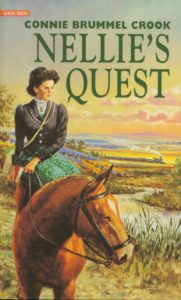For awards, reviews, excerpts and other information please scroll down.

Publisher: Toronto: Stoddart Kids Publishing, 1998.
Cover Art: David Craig
Summary: The second in the Nellie McClung trilogy, where Nellie is teaching school near home and she begins her life’s work to help women. Also, the romance between Nellie and Wes McClung begins.
AWARDS
Geoffrey Bilson Historical Fiction shortlist, 1998
Canadian Children Book Centre’s Our Choice selection, 1998
REVIEWS
Review from Quill & Quire
If you crossed Anne of Green Gables with Little House on the Prairie and added a sharper political focus, the hybrid might resemble Nellie’s Quest. This is the second of Connie Brummel Crook’s thoroughly researched and intelligently written novels about Canadian women’s rights activist Nellie McClung. . . .careful attention to detail and respect for historical accuracy is a major strength of the novel . . . Nellie’;s character is engaging enough to capture the readers’ interest, a necessary first step in making history both relevant and inspiring.
— Quill & Quire
Crook effectively weaves historical fact – much of it drawn from Nellie’s biographical writings – and fictional dramatization, presenting Nellie and those around her as living, breathing people who suffer and persevere throughout their lives. Nellie’s Quest is a good read and, without being pushy about it, an educational one.
— The Hamilton Spectator
Nellie’s personal life is the highlight of the story as her sharp wit and sense of humour get her in and out of some trying situations.
— The Ottawa Citizen
Crook’s language is concise, accessible, and beautiful. The dialogue is believable, and the narrative is poignant. This is an excellent book to introduce a female role model to middle school boys and girls. Highly Recommended.
— Tim Gavin, Director of Media Services, The Episcopal Academy, Merion, Pennsylvania
EXCERPTS
“I told you loud and clear – get out and get off my land.”
For Nellie, everything started to come into focus. On the stone stoop just inside the stable door stood a thin man with dark brown hair. One large swatch of his unruly mop was plastered down onto his sweating forehead. His eyes were glassy and there was a leer on his face.
“Mr. Sayers, what . . . what are you-”
Nellie was about to ask the farmer why he was inside the barn on a day that was perfect for harvesting. But fortunately, he spoke first. She was in enough trouble just being on his property.
“Well, if it isn’t Miss Mooney,” Sayers mumbled thickly. “And what are you doing here on my land?” He shuffled closer and stared at Nellie through narrowed eyes. He was unsteady on his feet and leaning heavily on his pitchfork. The smell of his alcoholic breath was strong.
“I’ve come to see Sarah, and there was no answer to my knocking at the house,” Nellie said evenly, though she was trembling inside. “We’ve missed her at school. Has she been sick?”
In this second book in the series, Nellie – a young schoolteacher – still struggles to overcome her mother’s criticism and the prejudices of those around her. The thoughts and ideas on women’s rights and role of the family begin to take shape as she attempts to help Sarah, a young student in distress, with an alcoholic father and an intimidated and abused mother.
At the same time, Nellie’s romance with Wes McClung is growing. For once, she gets her mother’s approval–albeit somewhat mixed.
“Nellie,” she said, “you have more sense than I’ve given you credit for – and you certainly are getting something to look at, as you always said you would. I like your young man – I couldn’t have picked a finer one, myself. Now if you cannot get on, I’ll be inclined to think it will be your fault.”
Nellie chuckled after Mother left the room. As ever, she gave the men she liked all the credit. Then to herself, Nellie mumbled, “I’m glad you like, Wes, Mother, but someday, I’ll make my own mark..” (p. 193)